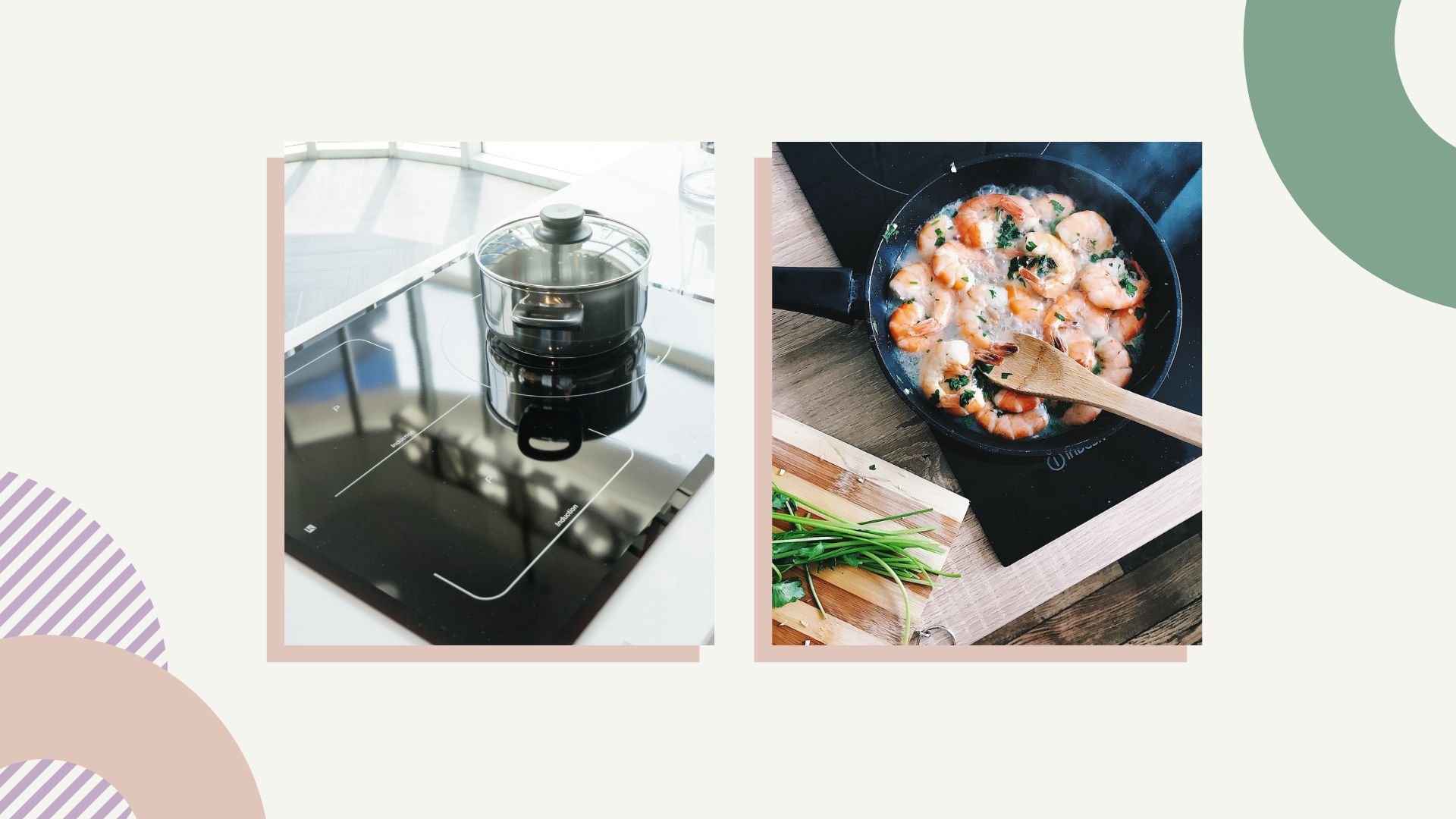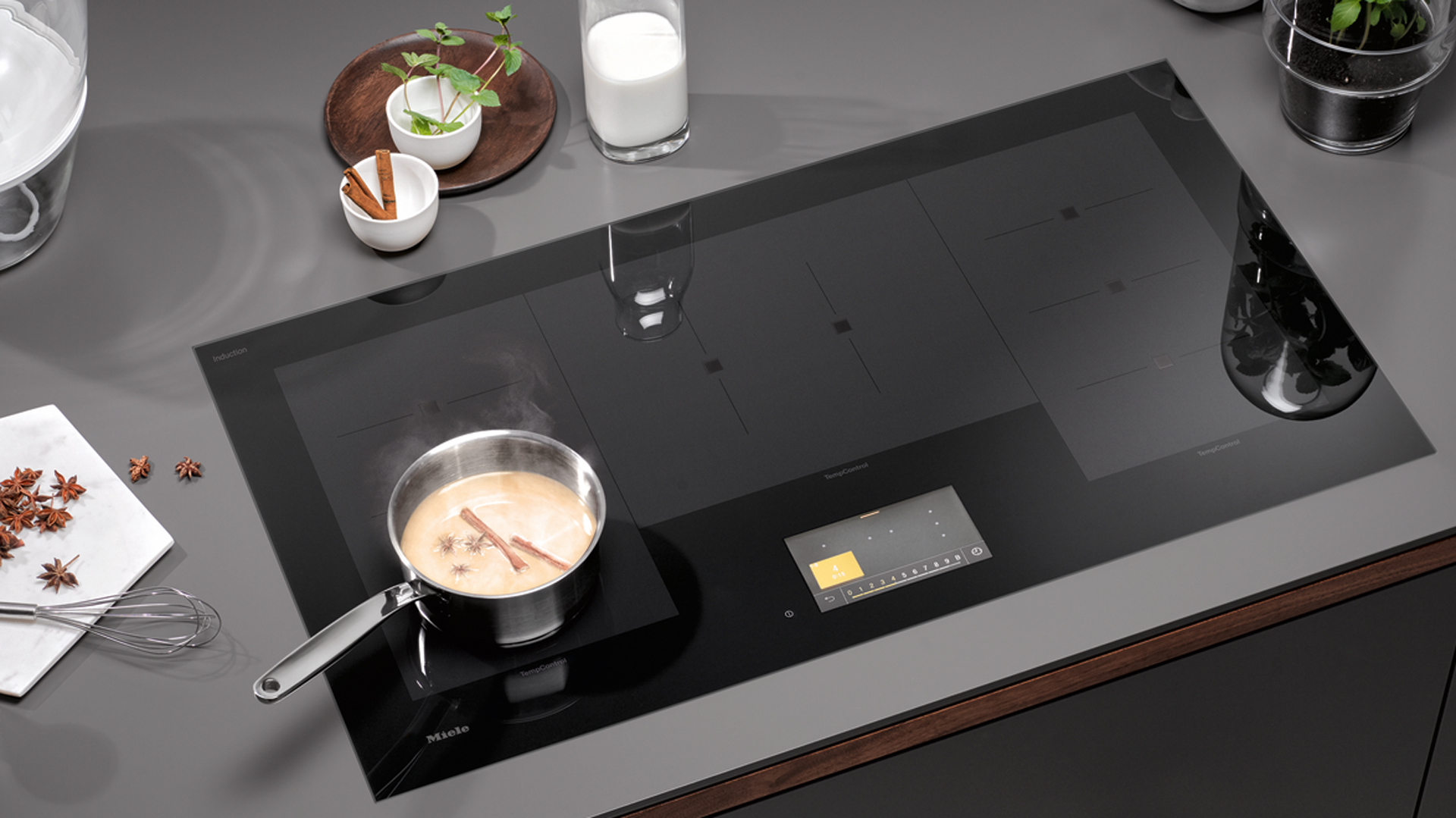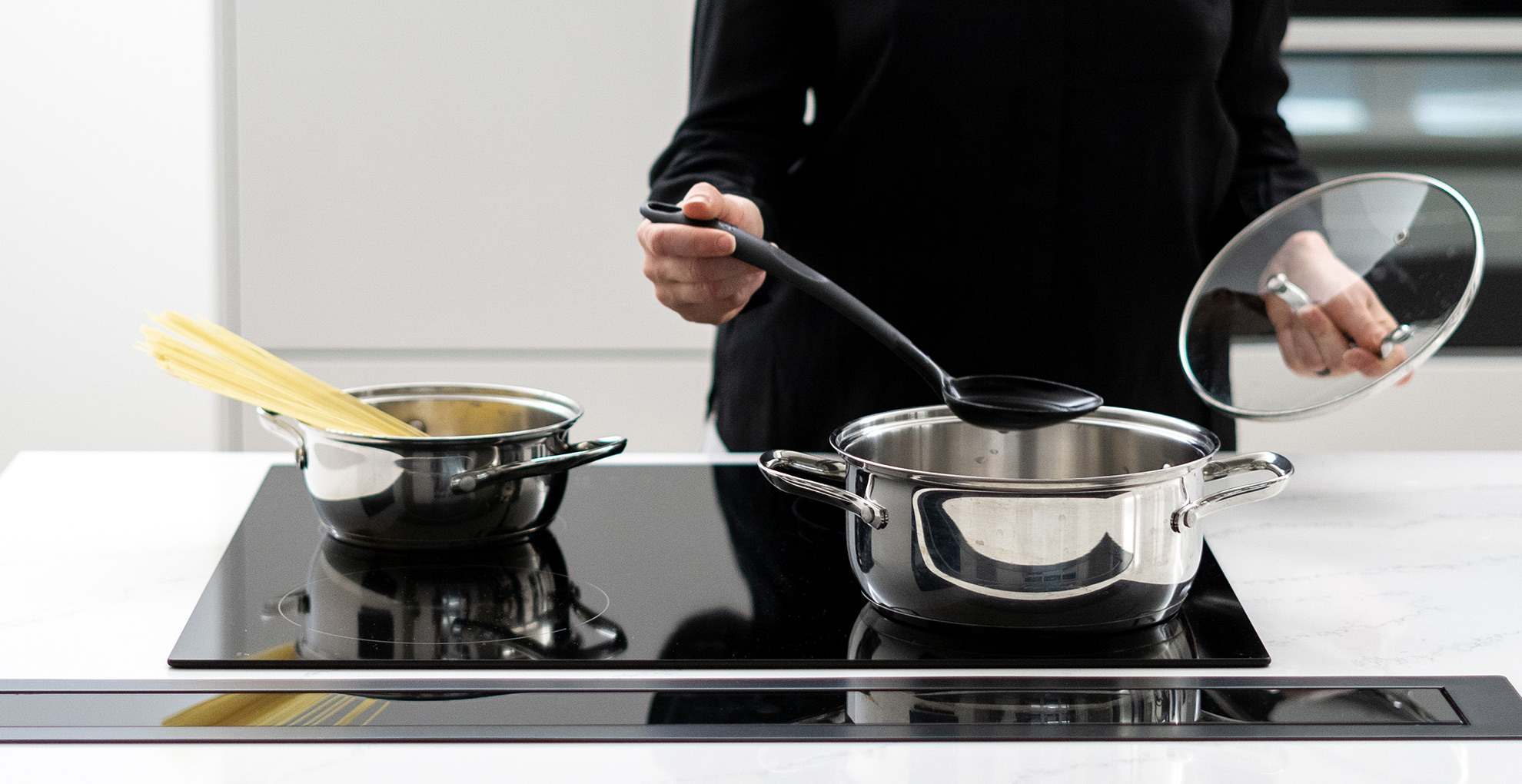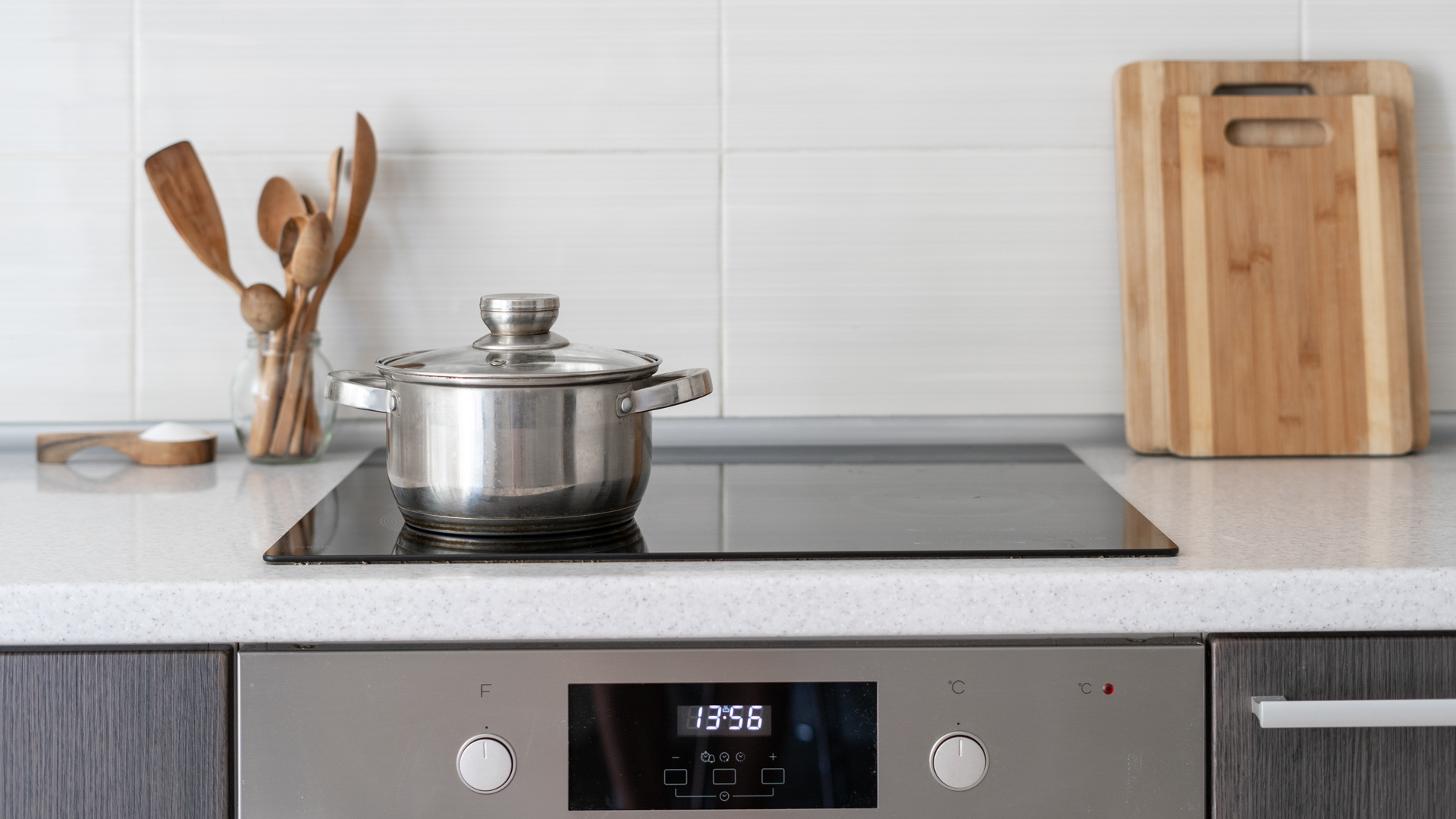Induction hob vs electric hob – which is the best electric option for you?
Choosing between an induction hob vs electric hob can be tricky unless you know what to look out for. Here we explain all...

Tamara Kelly
If you’re considering updating your kitchen with a brand new hob, you may well be weighing up whether to buy an induction hob or electric hob, wondering which is best. Should you go for the higher-tech option or should you stick with the tried-and-tested one? We consider the pros and cons of both to determine which is best for you.
Induction hobs, including even the best portable induction hobs, promise faster cooking, better energy efficiency, and easier cleaning than traditional electric hobs, but they can cost a lot more money, not to mention that you may need to buy alternative types of pans that will operate better with induction cooking.
We explore the main difference between the two modern hobs, the costs of buying and running, along with the benefits of cooking with each option. In this guide, 'electric hob' refers to old-style solid-plate electric hobs and more modern ceramic electric hobs, too. If, by the end, you decide an induction hob is for you, don't forget to check out our buying guide for the best induction pans too.
Induction hob vs electric hob: what are the key differences?
Induction hobs and electric hobs might feel like the same thing because, unlike the induction hob vs gas hob debate, both are very similar in that they are powered by electric mains – but there are key major differences.
"Electric and induction hobs look very similar on the surface however, they are very different appliances," explains Sophie Lane, product training manager at Miele. "The main difference between them is the way they create heat."
"Electric hobs use conventional radiant heat," Sophie explains, "the heat is transmitted by means of conduction. When turned on, its heating elements will heat the active ring and its surrounding surface. The heat then transfers from the surface of the hob to the pan and then to the food."
So how do induction hobs work that differs from electric hobs? "Induction hobs heat up pans through electrical induction. This means that the hobs have copper coils fitted beneath the surface which produce a magnetic field when switched on. The magnetic field only heats the base of the pan and the rest of the surface remains relatively cool. Induction hobs are a very energy-efficient option for this reason."
Sign up for the woman&home newsletter
Sign up to our free daily email for the latest royal and entertainment news, interesting opinion, expert advice on styling and beauty trends, and no-nonsense guides to the health and wellness questions you want answered.
Penelope Jacobs, kitchen expert at MyJobQuote summarizes the difference, telling us "induction hobs are different in comparison to other hobs as they heat the pan rather than heating the hob ring. They do this through a magnetic field below the surface. When a pan is placed on the surface, this completes the circuit and, therefore, heats the base of the pan."

Is induction cheaper than electric?
"Although induction hobs tend to be more expensive in terms of upfront costs, they are considerably more efficient and cost-effective compared to electric hobs in the long term as they use less energy and are cheaper to operate," explains Les Roberts, the content manager at energy bill experts Bionic.
"Induction hobs make use of electromagnetic energy so they only work when a pan makes contact with the surface and an alternating electric current is passed through the copper coils under the surface," Les explains. "Placing a magnetized pan on the top creates a magnetic field that heats the pan up. This reduces heat loss as only the surface of the pan is heated, not the entire hob surface."
"Once the pan is removed, the current is cut off instantly and the surface cools very rapidly, increasing the efficiency as the heat is not lost to the surrounding environment, unlike electric hobs. Around 90% of the heat generated by an induction hob is transferred to food for cooking, whilst with a traditional electric hob this number is only 70%, due to heat loss."
Given the efficient nature of an induction hob, the contents of your pan will heat much quicker, cutting down on cooking time and therefore cutting down on costs per use. Meaning it does prove cheaper than running an electric hob.
"There's no need to waste electricity boiling your pasta water in the kettle before transferring it to the pot as the water will boil in around half the time, compared to an electric hob."
Although Les does warn, "Do bear in mind, you may have to buy new pans if you invest in an induction hob because only magnetic pans can be used, which is an extra cost to consider. Stainless steel, cast iron, carbon steel, and a limited amount of metal cookware, coated in ceramic can be used."

Induction hob vs electric hob: initial cost and running costs
"Induction cooking is much quicker than electric or gas cooking, and since you’re only heating the pan, it’s also much more energy efficient," explains Penelope.
"Induction hobs use around 90% of the heat generated for cooking. Electric hobs use around 70% of the generated heat for cooking. This is quite a difference in terms of energy efficiency."
Because induction hobs are more efficient than electric hobs almost all of their energy gets turned into usable heat so in that sense, they're more cost-efficient. But the annual savings aren’t dramatic, think around $20/£20 a year unless you’re cooking for an army - so it all depends on how much you cook, and if you need multiple hobs. Induction hobs can heat food almost twice as fast as electric hobs, so they also carry that benefit.
Like when working out how much it costs to run an air fryer think about the cost upfront and then the cost per use. "The upfront costs of induction hobs tend to range from around £150 - £2,000 ($175 - $2,300), with the average price falling at around £500 ($577). Electric hobs are cheaper to buy upfront, with prices ranging from around £120 - £700 ($138 - $810) and the average price falling at around £250 ($290)," explains Penelope.
"If you cook a lot or if you tend to use multiple hob rings at once when cooking, it would be worth spending the extra money on investing in an induction hob as the energy savings will easily pay for themselves before it’s time to replace your hob. You’ll also benefit from faster cooking times. If you only cook occasionally and you’re on a budget, an electric hob is likely the better choice."
Induction hob vs electric hob: do you need new pans?
An electric hob will work with all of your existing pots and pans, from stainless steel pans to your best wok, although if you’re coming from gas and have a round-bottomed wok, you’ll need to swap it for a flat-bottomed one. Other than that, everything will work fine, and your pan storage situation needn't change too much.
With an induction hob, you need magnetic cookware sets, and that rules out copper, glass, and aluminum unless they have a magnetic plate in the bottom. If in doubt, grab a fridge magnet and put it at the bottom of the pan. If it sticks, the pan should be OK. To ensure you have the right cookware for the job you might be best investing in one of the best induction pans too.

Induction hob vs electric hob: what are the key benefits of both?
The main benefit of a standard electric cooker is that it’s cheap to buy and therefore a better option for those on a budget. You can also use most pots and pans on them which alleviates the need to buy any new cookware.
The key advantage of an induction cooker is that it cooks more efficiently and quickly, delivers finer control of very low and very high temperatures, and is much easier to clean. An induction hob doesn’t get hot, it warms up the pots and pans via magnetism so food is much less likely to get burnt on – so cleaning stainless steel pans feels easier, no more wondering how to clean a burnt pan.
"There are numerous benefits to this direct method of heating the base of a pan," says Sophie of the mechanisms of induction hobs. "Firstly, it does not produce any heat losses – in contrast to appliances such as electric hobs, whose ceramic glass needs to be heated before the pan on top is able to start heating up. As a result, induction technology can achieve time savings of up to 50% compared with conventional electric hobs. This in turn can lead to approximately 25% lower energy requirements."
Another benefit of cooking on induction is the safety aspect. "Induction is safer than standard types of technology too, for reasons including the fact that no energy is released until the pan is placed on the hob," Sophie explains. "This means that there is no risk of burns if a hob is accidentally switched on without a pan on it."
"Depending on the sizes of the cooking zones, induction can make it possible to use a range of different pan sizes without the need to activate or deactivate additional heating circuits, something that is required in the case of electric hobs," says Sophie.
"The ceramic glass also stays relatively cool on induction hobs, making cleaning easier: burnt-on food is much quicker to remove and the direct control of the energy supply can even prevent the contents of a pan from boiling over.” Just ensure you read up on how to clean a glass-topped stove to avoid damaging the surface.
Induction hob vs electric hob: what are the key downsides?
The glass surfaces of induction hobs are easily scratched and can be smashed, and despite their energy-saving credentials, they are more expensive. These costs rise again when you consider that you'll need to use compatible cookware.
In contrast, electric hobs are cheaper and are fairly brutish things – slower to heat up, slower to adjust, and slower to cool down. It's also easier to overcook things as you simply don't have the same precise temperature controls as you do with induction hobs. Finally, although they can be hardier, they're also often trickier to clean than induction hobs.
Induction hob vs electric hob: will you need to rewire?
Both kinds of electronic-powered cookers require hard wiring by an electrician, you can’t just plug them into a wall socket – so factor in those costs when buying either model. The ceramic electric hob requires a 6.6KW connection with a 30 amp fuse while the same firm’s induction hob needs a 7.4KW supply with a 32 amp fuse.
Induction hob vs electric hob: Verdict
If money’s no object, we’d pick the induction hob every time – very much the same conclusion we came to in the induction hob vs gas hob debate too.
Induction hobs feel a little like cooking with magic because the hob itself doesn’t heat up and yet it can deliver impressive heat incredibly quickly to heat the pans for more efficient cooking. If you’re a serious steak searer or stir-fryer, you’ll love what it can do although if you’re new to induction, you’ll have to rethink your favorite recipes because everything cooks so much more quickly. It’s a shame that you can’t use every kind of pan on it, but that’s a sacrifice we’re willing to make.
Writer and broadcaster Carrie Marshall has been writing about all kinds of technology since 1998. Carrie’s CV is a who’s who of magazines, newspapers, websites and radio programs ranging from T3, Woman & Home, Techradar and MacFormat to the BBC, Sunday Post and People’s Friend, and she offers straight-talking tech advice on BBC Radio Scotland every Monday. Carrie has also written thirteen non-fiction books and ghost-written two more, and she has also been the co-writer of seven books and a Radio 2 documentary series. Her memoir, Carrie Kills A Man, will be published in late 2022.
- Tamara KellyLifestyle Editor
-
 Forget beach bags and sunnies, Jasmine Harman's ravishing red swimsuit was elevated by matchy-matchy lipstick
Forget beach bags and sunnies, Jasmine Harman's ravishing red swimsuit was elevated by matchy-matchy lipstickIf I want to make even the simplest outfit look a bit more polished, colour coordination becomes my style best friend.
By Emma Shacklock
-
 Lip contouring sounds a bit much, but this modern makeup technique is the 'soft' way to cheat a fuller pout
Lip contouring sounds a bit much, but this modern makeup technique is the 'soft' way to cheat a fuller poutThink about how you use your favourite bronzer, then apply the same principle to your lips - easy!
By Naomi Jamieson